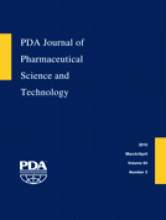Research ArticleTECHNOLOGY/APPLICATION
The Bacterial Diversity of Pharmaceutical Clean Rooms Analyzed by the Fatty Acid Methyl Ester Technique
Fábio Luiz C. Pacheco and Terezinha De Jesus A. Pinto
PDA Journal of Pharmaceutical Science and Technology March 2010, 64 (2) 156-166;
Fábio Luiz C. Pacheco
Terezinha De Jesus A. Pinto

References
- 1.↵
- La Duc M. T.,
- Dekas A.,
- Osman S.,
- Moissl C.,
- Newcombe D.,
- Venkateswaran K.
- 2.↵
PDA. Technical Report 13: Fundamentals of an environmental monitoring program. PDA J. Pharm. Sci. Technol. 2001, 55 (5) supplement, 11–17.
- 3.↵
ISO 14644-1. Part 1: Classification of Air Cleanliness. IEST: Arlington Heights, IL, 1999.
- 4.↵
USP 31 Chapter 1116. Microbiological evaluation of clean rooms and other controlled environments. United States Pharmacopeial Convention: Rockville, MD, 2008.
- 5.↵
- 6.↵
- 7.↵
- Moissl C.,
- Osman S.,
- La Duc M.,
- Dekas A.,
- Brodie E.,
- Desantis T.,
- Venkateswaran K.
- 8.↵
MIDI. SHERLOCK Analysis User's Manual—Version 6.0; MIDI: Newark, NJ, 2005; p 66.
- 9.↵
- Paisley R.
- 10.↵
- Quezada M.,
- Buitrón G.,
- Moreno-Andrade I.,
- Moreno G.,
- Lopez-Marín L. M.
- 11.↵
- Kosdrój J.,
- Van Elsas J. D.
- 12.↵
- Werker A. G.,
- Hall E. R.
- 13.↵
- Quivey R. G.,
- Kuhnert W. L.,
- Hahn K.
- 14.↵
- Giotis E. S.,
- McDowell D. A.,
- Blair I. S.,
- Wilkinson B. J.
- 15.↵
- Chen Q.,
- Nijenhuis A.,
- Preusting H.,
- Dolfing J.,
- Janssen D. B.,
- Witholt B.
- 16.↵
- Nielsen L. E.,
- Kadavy D. R.,
- Rajagopal S.,
- Drijber R.,
- Nickerson K. W.
- 17.↵
- Wiggins R. J.,
- Wilks M.,
- Tabaqchali S.
- 18.↵
- Welch D. F.
- 19.↵
- McNabb A.,
- Shuttleworth R.,
- Behme R.,
- Colby W. D.
- 20.↵
- Yamamoto K.,
- Murakami R.,
- Takamura Y.
- 21.↵
- Haack S. K.,
- Garchow H.,
- Odelson D. A.,
- Forney L. J.,
- Klug M. J.
- 22.↵
- Todar K.
- 23.↵
- Lim Y. W.,
- Moon E. Y.,
- Chun J.
- 24.↵
- Martin V. J. J.,
- Yu Z.,
- Mohn W. W.
- 25.↵
- Stackenbrandt E.,
- Koch C.,
- Gvozdiak O.,
- Schumann P.
In This Issue
PDA Journal of Pharmaceutical Science and Technology
Vol. 64, Issue 2
March/April 2010
The Bacterial Diversity of Pharmaceutical Clean Rooms Analyzed by the Fatty Acid Methyl Ester Technique
Fábio Luiz C. Pacheco, Terezinha De Jesus A. Pinto
PDA Journal of Pharmaceutical Science and Technology Mar 2010, 64 (2) 156-166;
Jump to section
Related Articles
- No related articles found.
Cited By...
- No citing articles found.





